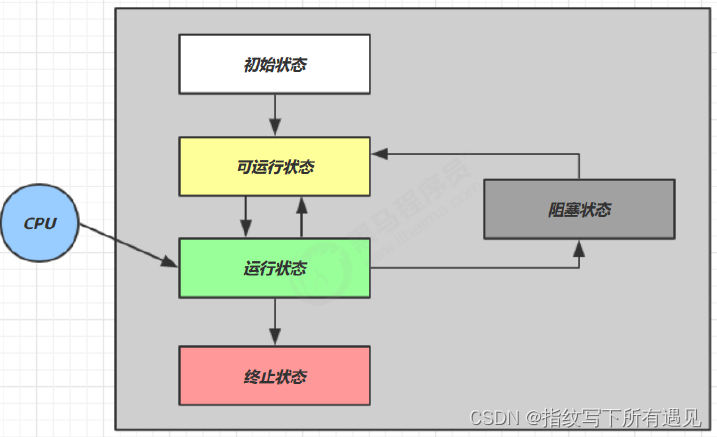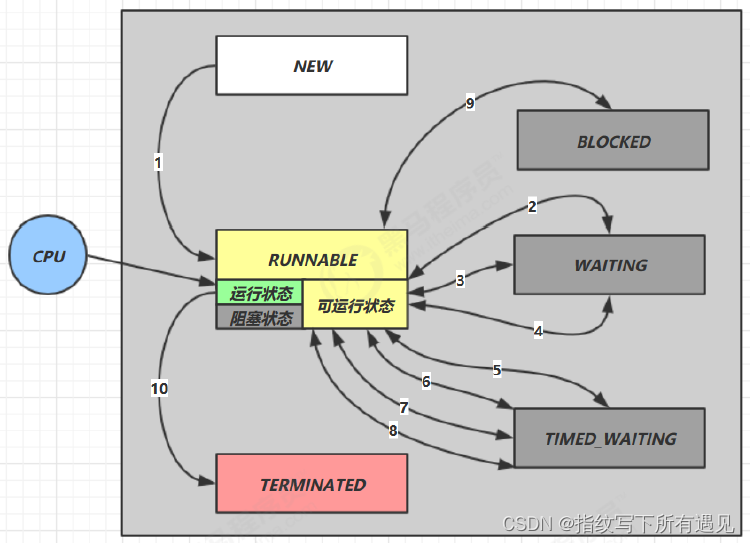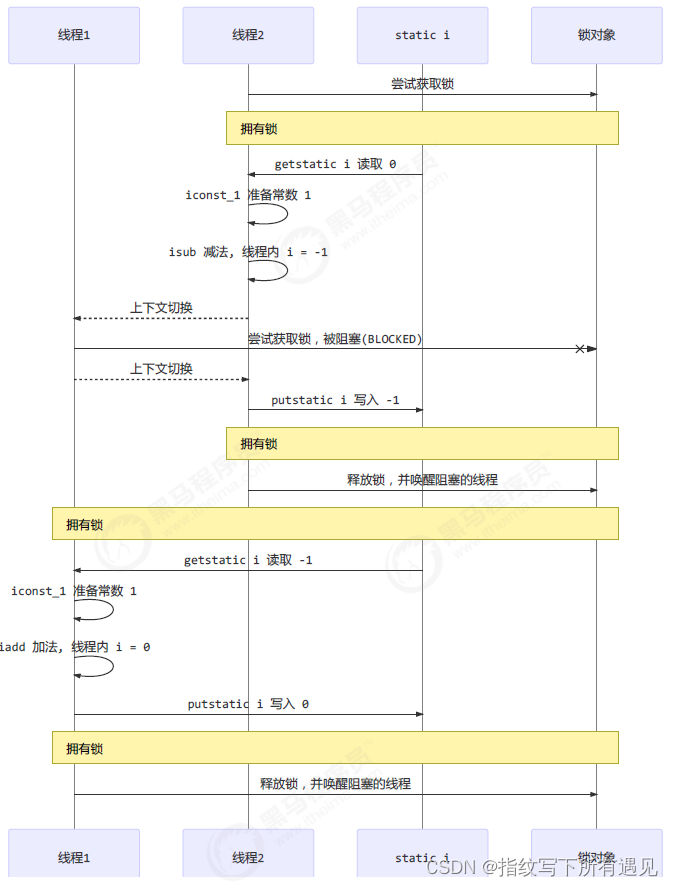今天多搞一点
两阶段终止模式
概念
两阶段终止模式(Two-Phase Termination Pattern)是一种设计模式,通常用于多线程编程中确保系统在终止前能平稳、有序地关闭其资源和线程。这种模式特别适合用于需要优雅关闭操作的应用程序,如多线程的服务器或者需要清理资源的复杂系统。
基本工作原理
-
第一阶段 - 触发终止:
- 在这一阶段,系统接收到终止信号(例如用户输入、系统命令或其他形式的触发条件)。这个信号会通知程序开始准备关闭。
- 程序设置一个终止标志,表明系统即将关闭。
-
第二阶段 - 执行终止:
- 一旦终止标志被设置,系统将执行具体的终止操作。这可能包括关闭资源(如文件、网络连接)、停止服务、通知所有工作线程结束等。
- 这个阶段的关键是确保所有关键资源都被正确释放,所有线程都能有序地终止。
在一个线程t1中优雅的终止t2线程(给t2一个料理后事的机会)
例如使用stop()方法杀死线程这显然是不靠谱的,System.exit()方法这种直接把整个程序都停止了,显然都不行。示例代码在此。(打断线程有isInterrupted()方法和interrupted()方法,前者不会清除打断标记,后者会清除打断标记)
@Slf4j(topic="c.Test3")
public class Test3 {
public static void main(String[] args) throws InterruptedException {
TwoPhaseTermination tpt=new TwoPhaseTermination();
tpt.start();
Thread.sleep(5000);
tpt.stop();
}
}
@Slf4j(topic="c.TwoPhaseTermination")
class TwoPhaseTermination{
private Thread monitor;//监控线程
//启动监控线程
public void start(){
monitor=new Thread(()->{
while (true){
Thread current= Thread.currentThread();
if(current.isInterrupted()){
log.debug("料理后事");
break;
}
try {
Thread.sleep(1000);
log.debug("执行监控记录");
} catch (InterruptedException e) {
e.printStackTrace();
//重新设置打断标记,没有这句话的话无法正确退出循环,因为sleep出现异常后会清除打断标记
current.interrupt();
}
}
});
monitor.start();
}
//停止监控线程
public void stop(){
monitor.interrupt();
}
}打断park线程,这个感觉不用说太多,需要注意的是如果打断标记为真,park就会失效,比如可以用interrupted()方法打断后自动清除打断标记。
不太好的方法
stop()、suspend()、resume(),这些容易破坏同步代码块,造成线程死锁。
主线程和守护线程
默认情况下,Java 进程需要等待所有线程都运行结束,才会结束。有一种特殊的线程叫做守护线程,只要其它非守护线程运行结束了,即使守护线程的代码没有执行完,也会强制结束。
最常见的应用是垃圾回收器,Tomcat 中的 Acceptor 和 Poller 线程都是守护线程,所以 Tomcat 接收到 shutdown 命令后,不会等待它们处理完当前请求
线程的状态-五种状态(操作系统层面描述)
勾起了我尘封的回忆

【初始状态】仅是在语言层面创建了线程对象,还未与操作系统线程关联
【可运行状态】(就绪状态)指该线程已经被创建(与操作系统线程关联),可以由 CPU 调度执行
【运行状态】指获取了 CPU 时间片运行中的状态,当 CPU 时间片用完,会从【运行状态】转换至【可运行状态】,会导致线程的上下文切换
【阻塞状态】
如果调用了阻塞 API,如 BIO 读写文件,这时该线程实际不会用到 CPU,会导致线程上下文切换,进入【阻塞状态】等 BIO 操作完毕,会由操作系统唤醒阻塞的线程,转换至【可运行状态】
与【可运行状态】的区别是,对【阻塞状态】的线程来说只要它们一直不唤醒,调度器就一直不会考虑调度它们
【终止状态】表示线程已经执行完毕,生命周期已经结束,不会再转换为其它状态
线程的状态-六种状态(Java Api层面描述)

NEW 线程刚被创建,但是还没有调用 start() 方法
RUNNABLE 当调用了 start() 方法之后,注意,Java API 层面的 RUNNABLE 状态涵盖了操作系统层面的【可运行状态】、【运行状态】和【阻塞状态(由于 BIO 导致的线程阻塞,在 Java 里无法区分,仍然认为是可运行)
BLOCKED , WAITING , TIMED_WAITING 都是 Java API 层面对【阻塞状态】的细分
TERMINATED 当线程代码运行结束
一个练习
给一个多线程解决方案

两个线程拿下,这个解法还是有一定缺陷的,确实离真正的实际还有一定差距
@Slf4j(topic ="c.Test4")
public class Test4 {
public static void main(String[] args) {
//线程1用来洗水壶和烧开水
Thread t1=new Thread(()->{
log.debug("{}开始洗水壶",Thread.currentThread().getName());
try {
Thread.sleep(1000);
} catch (InterruptedException e) {
throw new RuntimeException(e);
}
log.debug("{}开始烧开水",Thread.currentThread().getName());
try {
Thread.sleep(15000);
} catch (InterruptedException e) {
throw new RuntimeException(e);
}
},"t1");
Thread t2=new Thread(()->{
log.debug("{}开始洗茶壶",Thread.currentThread().getName());
try {
Thread.sleep(1000);
} catch (InterruptedException e) {
throw new RuntimeException(e);
}
log.debug("{}开始洗茶杯",Thread.currentThread().getName());
try {
Thread.sleep(2000);
} catch (InterruptedException e) {
throw new RuntimeException(e);
}
log.debug("{}开始拿茶叶",Thread.currentThread().getName());
try {
Thread.sleep(1000);
} catch (InterruptedException e) {
throw new RuntimeException(e);
}
try {
t1.join();
} catch (InterruptedException e) {
throw new RuntimeException(e);
}
log.debug("{}开始泡茶喽",Thread.currentThread().getName());
},"t2");
t1.start();
t2.start();
}
}结果
14:19:22 [t2] c.Test4 - t2开始洗茶壶
14:19:22 [t1] c.Test4 - t1开始洗水壶
14:19:23 [t1] c.Test4 - t1开始烧开水
14:19:23 [t2] c.Test4 - t2开始洗茶杯
14:19:25 [t2] c.Test4 - t2开始拿茶叶
14:19:38 [t2] c.Test4 - t2开始泡茶喽共享模型之管程
共享带来的问题
这里我觉得细说的必要不大,这个代码的结果千奇百怪,字节码指令交错加上上下文切换
@Slf4j(topic = "c.Test5")
public class Test5 {
static int counter = 0;
public static void main(String[] args) throws InterruptedException {
Thread t1 = new Thread(() -> {
for (int i = 0; i < 5000; i++) {
counter++;
}
}, "t1");
Thread t2 = new Thread(() -> {
for (int i = 0; i < 5000; i++) {
counter--;
}
}, "t2");
t1.start();
t2.start();
t1.join();
t2.join();
log.debug("{}",counter);
}
}临界区 Critical Section
一个程序运行多个线程本身是没有问题的,问题出在多个线程访问共享资源,多个线程读共享资源其实也没有问题,在多个线程对共享资源读写操作时发生指令交错,就会出现问题,一段代码块内如果存在对共享资源的多线程读写操作,称这段代码块为临界区
竞态条件 Race Condition
多个线程在临界区内执行,由于代码的执行序列不同而导致结果无法预测,称之为发生了竞态条件
synchronized解决方案
它采用互斥的方式让同一时刻至多只有一个线程能持有【对象锁】,其它线程再想获取这个【对象锁】时就会阻塞住。这样就能保证拥有锁的线程可以安全的执行临界区内的代码,不用担心线程上下文切换
语法
synchronized(对象) // 线程1, 线程2(blocked)
{
临界区
}用它解决刚才的问题
@Slf4j(topic = "c.Test5")
public class Test5 {
static int counter = 0;
static Object lock=new Object();
public static void main(String[] args) throws InterruptedException {
Thread t1 = new Thread(() -> {
for (int i = 0; i < 5000; i++) {
synchronized (lock){
counter++;
}
}
}, "t1");
Thread t2 = new Thread(() -> {
for (int i = 0; i < 5000; i++) {
synchronized (lock){
counter--;
}
}
}, "t2");
t1.start();
t2.start();
t1.join();
t2.join();
log.debug("{}",counter);
}
}原理

synchronized 实际是用对象锁保证了临界区内代码的原子性,临界区内的代码对外是不可分割的,不会被线程切换所打断。
面向对象改进
@Slf4j(topic = "c.Test5")
public class Test5 {
public static void main(String[] args) throws InterruptedException {
Room room=new Room();
Thread t1 = new Thread(() -> {
for (int i = 0; i < 5000; i++) {
room.increment();
}
}, "t1");
Thread t2 = new Thread(() -> {
for (int i = 0; i < 5000; i++) {
room.decrement();
}
}, "t2");
t1.start();
t2.start();
t1.join();
t2.join();
log.debug("{}",room.getCounter());
}
}
class Room{
private int counter=0;
public void increment(){
synchronized (this){
counter++;
}
}
public void decrement(){
synchronized (this){
counter--;
}
}
public int getCounter(){
synchronized (this){
return counter;
}
}
}线程八锁
考察锁住的是哪个对象
情况1:显然可以锁住,锁的是同一个对象,结果是12或者21
@Slf4j(topic = "c.Number")
class Number{
public synchronized void a() {
log.debug("1");
}
public synchronized void b() {
log.debug("2");
}
}
public static void main(String[] args) {
Number n1 = new Number();
new Thread(()->{ n1.a(); }).start();
new Thread(()->{ n1.b(); }).start();
}情况2:1s后12或者2 1s后1
@Slf4j(topic = "c.Number")
class Number{
public synchronized void a() {
sleep(1);
log.debug("1");
}
public synchronized void b() {
log.debug("2");
}
}
public static void main(String[] args) {
Number n1 = new Number();
new Thread(()->{ n1.a(); }).start();
new Thread(()->{ n1.b(); }).start();
}
情况3:3肯定在1之前(3 1s 1 2)(2 3 1s 1)(3 2 1s 1)
class Number{
public synchronized void a() {
sleep(1);
log.debug("1");
}
public synchronized void b() {
log.debug("2");
}
public void c() {
log.debug("3");
}
}
public static void main(String[] args) {
Number n1 = new Number();
new Thread(()->{ n1.a(); }).start();
new Thread(()->{ n1.b(); }).start();
new Thread(()->{ n1.c(); }).start();
}情况4:2 1s 1 这里是两个对象,等于没有锁
@Slf4j(topic = "c.Number")
class Number{
public synchronized void a() {
sleep(1);
log.debug("1");
}
public synchronized void b() {
log.debug("2");
}
}
public static void main(String[] args) {
Number n1 = new Number();
Number n2 = new Number();
new Thread(()->{ n1.a(); }).start();
new Thread(()->{ n2.b(); }).start();
}情况5:2 1s 1这里a锁住的是类对象,b锁住的是示例对象,其实是不同的对象
@Slf4j(topic = "c.Number")
class Number{
public static synchronized void a() {
sleep(1);
log.debug("1");
}
public synchronized void b() {
log.debug("2");
}}
public static void main(String[] args) {
Number n1 = new Number();
new Thread(()->{ n1.a(); }).start();
new Thread(()->{ n1.b(); }).start();
}情况6:1s 1 2 或者2 1s 1 这里锁住的都是类对象
@Slf4j(topic = "c.Number")
class Number{
public static synchronized void a() {
sleep(1);
log.debug("1");
}
public static synchronized void b() {
log.debug("2");
}
}
public static void main(String[] args) {
Number n1 = new Number();
new Thread(()->{ n1.a(); }).start();
new Thread(()->{ n1.b(); }).start();
}情况7:2 1s 1 还是不同对象
@Slf4j(topic = "c.Number")
class Number{
public static synchronized void a() {
sleep(1);
log.debug("1");
}
public synchronized void b() {
log.debug("2");
}
}
public static void main(String[] args) {
Number n1 = new Number();
Number n2 = new Number();
new Thread(()->{ n1.a(); }).start();
new Thread(()->{ n2.b(); }).start();
}情况8:1s 1 2或者2 1s 1 无需多言
class Number{
public static synchronized void a() {
sleep(1);
log.debug("1");
}
public static synchronized void b() {
log.debug("2");
}
}
public static void main(String[] args) {
Number n1 = new Number();
Number n2 = new Number();
new Thread(()->{ n1.a(); }).start();
new Thread(()->{ n2.b(); }).start();
}




















 1231
1231











 被折叠的 条评论
为什么被折叠?
被折叠的 条评论
为什么被折叠?








